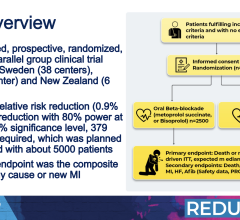Nov. 14, 2014 — Covidien releases 12-month results of the DEFINITIVE AR study, the first randomized study designed to identify the clinical benefits of plaque removal using directional atherectomy followed by drug-coated balloon. The results were presented by Professor Thomas Zeller of the Universitaets-Herzzentrum, Bad Krozingen, Germany at the Vascular Interventional Advances (VIVA) 2014 conference in Las Vegas, Nev.
DEFINITIVE AR results demonstrated higher technical success and lower incidence of vessel injuries known as flow-limiting dissections. Additionally, the study suggests the combination of directional atherectomy and anti-restenosis therapy with drug-coated balloons DAART) improves patency in long and severely calcified lesions. Longer lesions have lower patency across all current treatments, and presence of calcification may prohibit drug uptake and lead to less durability and loss of patency. Patency is the ability for the treated artery to remain open
“DEFINITIVE AR was designed as a hypothesis-generating study to detect trends in treatment differences between patients who were treated with DAART and patients who were treated with drug-coated balloons (DCB) alone. While the use of DCBs to treat peripheral artery disease has demonstrated reduced restenosis, there have been limited clinical studies evaluating the effectiveness of DCBs in complex disease,” said Professor Zeller. “The results suggest DAART may address an unmet clinical need in difficult to treat long or severely calcified lesions.”
Duplex Ultrasound primary patency rates for the long (?10 cm) lesion subset at 12 months were 96.8 percent in patients treated with DAART compared to 85.9 percent in patients treated with DCB alone. Primary patency rates at 12 months in severely calcified lesions, per core lab assessment, were 70.4 percent in DAART patients compared to 62.5 percent in DCB alone patients.
“Lumen gain, or the amount of plaque removed from the artery with directional atherectomy prior to DCB treatment, may also be a critical factor in contributing to the long-term clinical success of DAART therapy,” said Professor Gunnar Tepe, Klinikum Rosenheim, Germany. “This data suggests when the optimal amount of plaque is removed, that is <30 percent residual stenosis, the patency rate is improved.”
Results showed 94.1 percent primary angiographic patency for DAART when more plaque was removed with directional atherectomy (less than 30 percent residual stenosis was achieved) compared to 68.8 percent patency when less plaque was removed (more than 30 percent residual stenosis) prior to treatment with the DCB. Directional atherectomy is unique as it allows for the largest amount of luminal gain while maintaining vessel integrity.
The primary endpoint of the study was defined as the percent stenosis (narrowing of the vessel), at one year per Angiographic Core Lab assessment. At 12 months, the percent stenosis in the randomized groups was 33.6 ± 17.7 for the DAART arm compared to 36.4 ± 17.6 for the DCB arm. These results were observational, as the study was not powered to detect differences between the groups.
“This small but rigorous pilot study suggests an added benefit for DAART over DCB in challenging lesions,” said Mark Turco, M.D., chief medical officer, Vascular Therapies, Covidien. “Further investigation in larger, prospective, statistically-powered randomized trials is warranted to confirm the positive trends observed in DEFINITIVE AR and to evaluate a possible economic advantage to a DAART strategy. Covidien continues to invest in the DEFINITIVE AR study, and patients will be followed out to 24 months to assess the durability of the results.”
For more information: www.covidien.com


 April 11, 2024
April 11, 2024 








